by Heather Kent | Aug 29, 2022
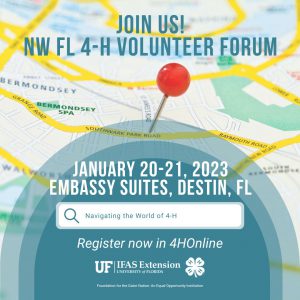 We are excited to announce registration for our 2023 Northwest Florida 4-H Volunteer Forum will open on October 15th! This post contains all the details about our event- who, what, when, where, and how. We hope you will plan to join us for an inspirational Friday night and Saturday as we connect with each other, learn together, and share our successes. Our theme is “Navigating the World of 4-H.” Together, we will learn about empowering youth, inspiring hope, and helping young people reach their full potential.
We are excited to announce registration for our 2023 Northwest Florida 4-H Volunteer Forum will open on October 15th! This post contains all the details about our event- who, what, when, where, and how. We hope you will plan to join us for an inspirational Friday night and Saturday as we connect with each other, learn together, and share our successes. Our theme is “Navigating the World of 4-H.” Together, we will learn about empowering youth, inspiring hope, and helping young people reach their full potential.
WHO
|
Our volunteer forum is for teen and adult volunteers leading and supporting 4-H clubs, groups, or programs in the northwest Extension district. |
WHAT
|
A weekend (Friday night and Saturday) event full of inspirational speakers, hands-on workshops, and opportunities to connect with and support other volunteers! Topics were identified based on last year’s forum participants’ feedback. Feel free to download the agenda and informational flyer. This post highlights some of the activities you won’t want to miss:
Friday night kicks off with our “Make and Take” Fair. Try out a wide variety of fun and exciting 4-H activities you can use with the clubs or groups you work with. Each time you visit a station, you can get your “passport” stamped! There will be selections to support all three 4-H pillar project areas- Healthy Living, STEM (science), and Citizenship/Leadership. During the Make and Take Fair, heavy hors d’oeuvres will be served and you will have the opportunity to test out the activities and take home samples and instructions to share with your youth, parents, and other volunteers.
After the make-and-take fair, we will have a fun icebreaker, and Dr. Stacey Ellison, our 4-H Program Leader, will speak and give a “state of 4-H” update and share strategies for inclusion and diversity. Volunteers are encouraged to network and mingle after her address.
Saturday morning will inspire! Gulf County 4-H Alumnus and best-selling author, Cedric Lennox, will share how his Florida 4-H experiences taught him about youth empowerment and how we can all be “Dealers of Hope.”
Following the keynote address, volunteers will be able to select from a variety of workshops:
- Road Map to Parliamentary Procedure
- Charting a Successful Sports Fishing Project
- Culinary Adventures with the 4-H Food Challenge
- Trek through Teambuilding
- Tour of 4-H Gardening Project
- Smooth Sailing with Cloverbuds
During lunch, connect with other volunteers who have similar interests as you to start building a community of practice for your 4-H clubs and groups! Dr. Jenny Jordan will share expert tips for Experiential Learning (or learn-by-doing).
After lunch, there will be more workshop selections for volunteers to choose from:
- Guide to 4-H Awards, Recognition, & Portfolios
- Voyage through the 4-H Clothing & Textiles Project
- Hike through the “Big Book of Cloverbuds”
- Survey of Service Learning
- Expeditions in Entomology
- A Mindfulness Pilgrimage
We will close our forum by sharing some exciting new resources- including a fundraising toolkit for 4-H volunteers (and more door prizes!). |
WHEN
|
January 20-21st. |
WHERE
|
Embassy Suites in Destin, Florida. No need to make a reservation- your registration is your hotel reservation confirmation! |
HOW
|
Registration opens in 4Holine on October 15th. The deadline to register is Friday, January 6th. Check with your local UF/IFAS Extension office to inquire about carpooling to and from the event. Dress for the weekend is casual (and comfortable)- we will be at the beach! |
HOW MUCH
|
Thanks to donations from the Florida 4-H Foundation and other partners, the registration fee for individuals sharing a suite with another volunteer is $100. The registration fee for a private suite is $150. The registration fee includes the room fee, a conference welcome bag, magnetic name tag, heavy hors d’oeuvres Friday night, breakfast and lunch on Saturday, plus workshop and make-and-take supplies. Many counties are offering scholarships, so please check with your local UF/IFAS 4-H Extension Agent about additional funding. |
by aschortinghouse | Mar 31, 2023
Introduction
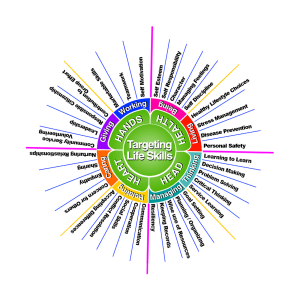
Figure 1: 4-H Life Skills Wheel Sources: (Hendricks, 1998) and (Norman & Jordan, 2018)
The goal of a 4-H program is for youth to learn about and develop life skills that will help them, in both the short term and long term, become contributors to their communities (Norman & Jordan, 2018). Life skills are the competencies or traits that relate to helping individuals’ function and navigate their lives.
When we begin planning 4-H programs with the end in mind, life skills are one of the considerations we should focus on. These skills should be identified during the planning process at the same time you are planning the objectives for each meeting. The life skills wheel illustrated in figure one serves as a tool to help visualize the most common life skills 4-H programs focus on. When we identify these skills, we can intentionally plan our programs to provide experiences that are specific and challenging without being overwhelming.
Often, we use projects and special interests as a hook to teach youth life skills. While some subjects are best suited to developing certain life skills, there are skills to be learned and developed no matter the exact subject being taught.
Getting Started
On the life skills wheel, all the life skills are categorized under the headings of head, heart, hands, and health which relates back to the 4-H pledge. By identifying the skills, you are targeting then planning activities to help you build those skills, you can build impactful programs that will continue to build on each other.
Let’s look at a scenario. We are working with a group of club officers at a training day preparing for the new 4-H year. The objectives for the meeting are for officers to learn their roles and for the youth learn more about each other so they are more comfortable working together. From here, we need to identify the skills we are hoping to build.
When you look at the life skills wheel there are numerous skills which could fit and be developed during this training. While some skills are built passively through experience, identifying three to five skills will help us identify activities and focuses that align with our objectives.
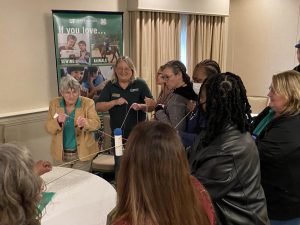
Picture 1: Volunteers participating in the bull ring activity at the 2023 NWD Volunteer Forum in Destin, Florida.
For this scenario, if we identify teamwork, problem-solving, communication, and planning/organizing as the life skills we intend to build, we need to identify activities that will build these skills. When working with activities we need to keep in mind that we need time for the do, reflect, apply model. So, once we do the activity, we need time for reflection, and a discussion on how we could apply what we have learned in the future.
If we look at this scenario a little bit closer, you will notice that some skills can be built during the same activity. An example of this would be if we were to use the bull ring activity, which has a tennis ball balanced on a ring by multiple strings are held by multiple participants standing in a circle as demonstrated in picture one, participants are going to use a bunch of life skills including communication, teamwork, problem-solving, and even planning. All these skills are necessary to successfully move the ball from point A to point B without dropping the ball. It is the intentional reflection and future application discussion of the skills that pulls in the impact and development of a skill beyond the passive learning that occurs.
Conclusion
4-H projects and meetings are an ideal environment for passive learning of life skills. However, it is the intentional planning of club and project leaders that results in active life skill development. So, as you are planning your next meeting, start with the end in mind. Identify your objectives and the life skills you want to develop, then intentionally plan activities and discussions which will lead youth through active thoughts and practice of the skills you are focusing on.
Resources
Hendricks, P. (1998). Developing youth curriculum using the targeting life skills model: Incorporating developmentally appropriate learning opportunities to assess impact of life skill development.
Norman, M., & Jordan, J. (2018, July 30). Targeting Life Skills in 4-H. https://edis.ifas.ufl.edu/publication/4H242
by Heather Kent | Jan 13, 2023
Did you know that MLK Day is the only federal holiday designated by US Congress as a national day of service? Instead of a “day off” from school or work, Americans are encouraged to spend the day serving others. Coretta Scott King said:
“The greatest birthday gift my husband could receive is if people of all racial and ethnic backgrounds celebrated the holiday by performing individual acts of kindness through service to others.” MLK Day is always the third Monday of January.
In honor of Dr. Martin Luther King, Jr.’s legacy of service, this blog post brings together several resources to support 4-H service projects to live out our motto, “make the best better.”
What is the Difference Between Service Learning and Community Service?
Service to the community is one of the pillars of 4-H membership. Our pledge includes “My HANDS to larger service.” All 4-H members and clubs are encouraged to plan and execute at least one service project each year. Community service and service learning are often confused. Community service can be court-mandated and sometimes has a negative connotation. However, the biggest difference between community service and service learning is that community service is usually a “one and done” activity where youth collect food, clothes, or other items for a local organization or pick up litter. There is nothing wrong with these types of activities, but youth usually have little input on them, and they are one-time events. This is perfect for younger youth. In contrast, service learning is a longer-term process where youth identify a community need, develop a proposal or plan to address that need, and often involve other community organizations or officials to take action. Service learning is a great way for older youth and teens to develop awareness and empathy. For more information about the differences between service learning and community service, check out our previous blog post.
Getting Youth Involved in Service to Others
Service to others is a huge part of the 4-H Model. Not only is it part of our pledge, Generosity is one of the 4-H Essential Elements, and something we strive to integrate throughout our programming. 4-H Clubs are encourages to participate in at least one community service or service learning project each year- it one of many standards for club and individual members. If you are not familiar with standards of excellence, it is part of our 4-H Awards and Recognition Program. To learn more, check out this previous blog post or be sure to attend our workshop on Awards and Recognition next weekend at our Northwest 4-H Volunteer Forum.
Finally, there is a grant program to help clubs with service learning! It’s called 4-H Community Pride, and not only does this program provide funding for service learning, there is a comprehensive leader’s guide to help volunteers, youth, and parents plan, execute, and celebrate thier service learning.
Ideas to Kick Start Community Service or Service Learning
If you are in need of some fresh ideas for service learning, be sure to read “17 Ways to Kick Start Your Service Learning.” We will also offer a workshop on Service Learning during our Northwest 4-H Volunteer Forum next weekend in Destin, FL. Finally, during our upcoming Northwest 4-H Teen Retreat, youth will have the opportunity to participate in a service project our youth planning committee selected. They will be making teddy bears to give away at a summer camp for youth with disabilities.
by Rachel Pienta | Dec 9, 2022
What is a Youth-Adult Partnership?
“Youth-adult partnership” is a frequently used phrase among 4-H leaders, volunteers, and members. Volunteer club leaders are encouraged to foster youth-adult partnerships in the community club environment. What is a youth-adult partnership? How would a volunteer club leader begin to create this type of partnership? What is the adult role in the youth-adult partnership? Research shows that “caring, knowledgeable, and skilled adults can contribute to the success of young people as they grow and develop (Norman and Jordan, 2006). The first step in creating a youth-adult partnership is being the adult who wants to foster that environment in their 4-H club.
Positive Youth Development
4-H programs are built on a Positive Youth Development foundation. To further unpack what that phrase means, let’s begin with defining youth development. Norman and Jordan (2006) define “Youth development as an ongoing process through which young people attempt to meet their needs and to develop the competencies they perceive as necessary for survival and transition to adulthood.” When youth development is positive, this development has positive benefits and outcomes for the youth and the community. While youth development is a youth-focused process experienced by the youth, adults can and do play a role in this process. Adult leaders have the unique and special role of creating environments that provide opportunities to develop and grow in positive ways.
Zone of Proximal Development and the Role of the Adult Leader
Sociologist Lev Vygotsky studied how children learn and acquire skills. Through his research, he was able to determine that children can develop and learn to a certain point based on prior experience and knowledge. With the help of an adult teacher or leader, the child can learn more and acquire skills beyond what he or she might be able to accomplish without adult help. This learning theory is known as the “Zone of Proximal Development” (Vygostky, 1978). In 4-H, reaching the zone of proximal development where the youth-adult partnership empowers youth members to achieve is the goal we work to reach.
Working with Youth as Partners
The origin of today’s 4-H youth-adult partnership model is rooted in the work of sociologist William Lofquist. Lofquist (1989) developed the “Spectrum of Attitudes” to describe adult attitudes and approaches to working with youth. The Spectrum of Adult Attitudes places attitudes towards young people into three categories: Youth as objects; Youth as recipients; and Youth as partners (Williams, 2016). Lofquist noted that adult attitudes and the behaviors that result from these attitudes were not necessarily linear or clear cut. Youth needs may drive adult behaviors at different points in the learning and partnership process. In 4-H, adult leaders strive to transition youth from being knowledge recipients to being partners in learning and doing.
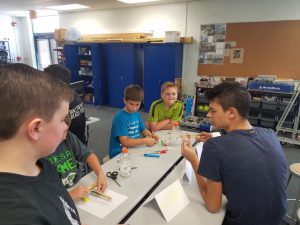
High school-age 4-H youth members plan and lead a 4-H robotics club.
Getting Started
Adults can foster and support successful youth-adult partnerships by creating and “providing environments for youth that are safe and nurturing and by expanding opportunities for experiences that will help young people develop skills they need for adulthood” (Norman and Jordan, 2006).
The idea of moving from an adult-led club to a club that operates as a youth-adult partnership may seem intimidating. Where do we start? How does it work? Volunteer club leaders may find that it takes a while to develop a community club that functions as a successful youth-adult partnership. Adults and youth may learn together as adults yield control and youth step into expanded leadership roles.
Tips for Establishing a Youth-Adult Partnership
In the club setting, creating space for shared decision-making can help build the youth-adult partnership. When adults make decisions “with” rather than “for” youth, space is created for youth voices to be heard, for youth decisions to be validated, and for youth to develop as leaders.
When youth make decisions about activities and projects, they begin to have ownership over the club experience and move toward acting as fully empowered partners with adult leaders.
How can adults create an environment that gives youth space to develop and grow as partners? Adult leaders can start building the youth-adult partnership by helping youth develop key skills to lead and run club meetings. Steps to reaching an effective youth-adult partnership include the following activities:
- Electing youth officers and providing officer training.
- Providing whole club training in parliamentary procedure with meeting procedure practice.
- Agenda planning that includes youth and adults.
- Adults joining youth-led meetings as participants.
- Setting ground rules so that everyone is heard and respected
Getting Started
For more information and resources on 4-H clubs and youth-adult partnerships, reach out to your local Extension office or 4-H agent.
We also have several tools and resources for office training, parliamentary procedure games, and agenda planning on our Northwest 4-H Volunteer Google Site. If you would like some hands-on training, make plans to attend our Northwest 4-H Volunteer Forum January 20-21 in Destin, Florida. Registration is available on 4HOnline
References
Lofquist, W. 1989. The technology of prevention workbook: A leadership development program. Tucson, AZ: Associates for Youth Development Publications.
Norman, M.N. and Jordan, J.C. 2006. Introducing 4-H youth development. EDIS 4HFFS101.2, one of a series of the 4-H Youth Development Department, UF/IFAS Extension. Original publication date February 2006. Reviewed July 2018. Visit the EDIS website at http://edis.ifas.ufl.edu.
Vygotsky, L. 1978. Interaction Between Learning and Development. In Gauvain & Cole (Eds.) Readings on the Development of Children. New York: Scientific American Books. pp. 34-40
Williams, C.D. 2016. What is authentic youth engagement? The Governor’s Office for Children. Maryland.gov. https://goc.maryland.gov/authentic-youth-engagement/.
Additional Resources
A 4-H Club Meeting
4-H Club Management
4-H Clubs that Youth Choose to Attend
Running a Smooth 4-H Business Meeting
by pmdavis | Dec 13, 2021
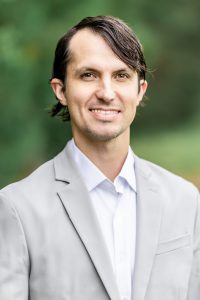
Meet Chris Lauen
“There’s No Place Like Holmes” – a phrase used in recent years to celebrate the opportunities that exist here in Holmes County, Florida. I find that many people try to figure out where our county is. Many locals say we are located right between Pensacola and Tallahassee, east and west– as well as Panama City Beach and Dothan, Alabama, north and south – right on the I-10 corridor. Many people know our community for our large annual rodeo, but most people out of state know we are their pathway to “The World’s Most Beautiful Beaches”. As a rural county with limited infrastructure, many young adults move elsewhere before realizing just how good of a place Holmes County is to raise a family and do life. I like to say, “The grass is green where you water it and my family and I choose to water it here.” Holmes County is growing and Holmes County 4-H will continue to do so as well.
My name is Chris Lauen and I grew up in the heart of Holmes County. One could even say it was the heart of Bonifay, the county seat, as my childhood home initially sat a few blocks from historic “downtown area”. Our home sat right on Highway 79 and faced the First Baptist Church. It was nestled next to the old Woman’s Club building and a “stones throw” from the Courthouse, Western Auto, and the “old” Bank of Bonifay. When the Bank of Bonifay (now First Federal Bank of Florida) chose to purchase the property from the church where my father was employed, my family ended up moving the home do a different property on the edge of town. That’s right – I managed to live in the same house with two different addresses. My weekly schedule as a child consisted of early mornings and late afternoons at Bonifay Elementary because that’s where my mom spent much of her career as the music teacher. Sundays were not much different as she typically played piano at First Baptist where my father has served as Minister of Music, Administrative Pastor, and a few other titles during my lifetime. My two older siblings would describe similar childhood experiences and still call Holmes County home, but reside with each of their families outside of Atlanta.
As I reach my middle school years, I would travel all over town as far as my bicycle or roller blades would take me, but my real playground was around any water that might have a fish hiding inside. I would bounce between the local ponds and creek and even prided myself in being able to catch some fish out of the ditches in the front of my home. My family supported my love for fishing and I’ll always remember my first days of surf fishing in Destin and my first trips on party and charter boats. I remember the sight of all of the big boats lined up at the harbor, the smells of diesel fumes from the engines wafting through the air combined with the odor of fish from the morning catch, and the overwhelming feelings of excitement about new adventures. For me, a driver’s license meant that I could find even more fish to catch, but also opened the door for more passions as my grandfather and great uncle passed down their old Browning A5 shotguns and a 1917 rifle. I enjoyed my new pursuit of new species, learning how to trap hogs, figuring out the best ways to get ducks to decoy, and looking for that big whitetail buck. With a driver’s license and other church members and mentors that liked to hunt and fish, I always tried to have a box of ammunition or fishing pole within reach. In the years ahead, my life revolved around school, hunting, fishing, attending or teaching at youth camps, foreign mission trips, playing music, and serving at our church.
Graduating from high school meant that I had the credentials to be a substitute teacher. With my mom still teaching and my history of literally growing up in and around the school, it didn’t take long for teachers to keep my calendar full based off their sick and vacation days. I was 17 years old. One week I was a student and somehow the next, a substitute teacher. I had the opportunity to attend Chipola College where I earned a degree in Professional Communication. I spent extra time on campus as a result of a Fine Arts scholarship and TV production scholarship. Whether it was running sound for the next big theatrical production or operating cameras at the athletic events, there were always opportunities to jump in, learn, and serve. After graduating from Chipola College, I went on to earn a Bachelor’s degree in Professional Communication as well as a Master’s degree in Corporate and Public Communication from Florida State University.
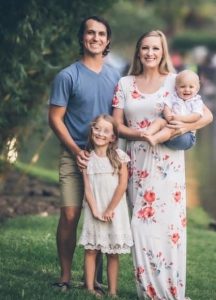
The Meet Family
In 2009, my days as a substitute teacher came to close as I accepted a position with the Florida Department of Health in Holmes County. From 2009-2021, I served in a few different capacities. My titles included Senior Human Services Program Specialist, Certified Contract Manager, Webmaster, and Public Information Officer. My responsibilities as a Program Lead included the development of a county-wide partnership, including youth and adults, who would advocate for change across social, political, and legal landscapes. We worked with key decision makers, elected officials, and the general public to promote healthy living for generations to come. While serving at the Department of Health, I actually had the opportunity to serve on the local Holmes County 4-H Advisory Council and even had some of our youth partner with Holmes County 4-H on some projects.
Here I am today, my family and I are starting a new chapter with 4-H and Holmes County. In ways the work is similar to what I’ve been doing for years, but in many ways – it’s different. It’s exciting to have a new platform to serve my community. I’ve been blessed with an entrepreneurial, music singing/playing, horse riding, water sport loving, wife who I met through an annual church music camp that both of our parents taught at. In my very biased opinion, we have two spectacular kids who also love the outdoors and bring us lots of joy. Our little girl, who is currently in 2nd grade, has an amazing heart and is super witty. She is very excited about her dad’s new job because she is a huge fan of arts and crafts, cooking, and music. She learned how to sleep on the front deck of a boat at an early age and already has her lifetime fishing and hunting license. Our little boy just turned two and loves a good hardback book. He’s learning new words every day, but mainly prefers to use the books as a ramp for his cars and monster trucks to drive over, around, and under. If there is a mud puddle within sight, you better hold him tight or he will be in it. As my kids grow older, I’m excited about the prospect of their future 4-H involvement.
As the new Holmes County 4-H Agent, I look forward to “making the best better” and working toward the 4-H vision of creating positive change in our youth, their families, and our communities. I guess I can say “that grass” my family is watering now includes 4-H.
We look forward to watching Holmes County 4-H grow!
 We are excited to announce registration for our 2023 Northwest Florida 4-H Volunteer Forum will open on October 15th! This post contains all the details about our event- who, what, when, where, and how. We hope you will plan to join us for an inspirational Friday night and Saturday as we connect with each other, learn together, and share our successes. Our theme is “Navigating the World of 4-H.” Together, we will learn about empowering youth, inspiring hope, and helping young people reach their full potential.
We are excited to announce registration for our 2023 Northwest Florida 4-H Volunteer Forum will open on October 15th! This post contains all the details about our event- who, what, when, where, and how. We hope you will plan to join us for an inspirational Friday night and Saturday as we connect with each other, learn together, and share our successes. Our theme is “Navigating the World of 4-H.” Together, we will learn about empowering youth, inspiring hope, and helping young people reach their full potential.




